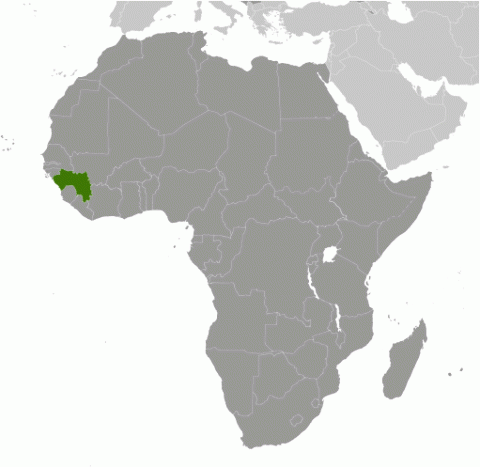Child Labor and Forced Labor Reports
Guinea


Moderate Advancement
In 2024, Guinea made moderate advancement in efforts to eliminate the worst forms of child labor. The Guinean government suspended activities in gold and diamond mines for 3 months in order to prevent child labor, human trafficking, and other human rights concerns, and issued four decrees to regulate the industry. These decrees require holders of mechanized mining concessions to prohibit the use of child labor. In addition, the Ministry of Women's Promotion, Children, and Vulnerable Persons assisted the United Nations High Commissioner for Human Rights in collecting data for a study on child labor in artisanal gold mining and the numerous risks children face in this sector. Several mining sites were visited and children, local authorities, and civil society activists interviewed. Finally, the government adopted a law to protect children under 18 years old from exploitation and the worst forms of child labor in farming. However, despite these efforts, Guinea does not meet the international standard for the minimum age for work. The country's legal protections do not cover children working outside of a formal employment relationship or children who are self-employed, and they allow children under the age of 13 to perform light work. In addition, the government lacks a coordinating mechanism and a national policy to address all relevant worst forms of child labor. Social programs also do not address the extent of the child labor problem.
| Children | Age | Percent and Population |
|---|---|---|
| Working | 5 to 14 | 31.2% (Unavailable) |
| Hazardous Work by Children | 15 to 17 | Unavailable |
| Attending School | 5 to 14 | 54.2% |
| Combining Work and School | 7 to 14 | 17.3% |
| Sector/Industry | Activity |
|---|---|
| Agriculture | Working in agriculture, including farming cashews, cocoa, and coffee, performing tasks such as picking, collecting, plowing the land, weeding, and transporting the harvest. Herding livestock. Working in fishing, sometimes with exposure to inclement weather, dangerous waters, dangerous equipment, poor sanitation, and lack of fresh food and water. Working in forestry, including transporting and carbonization in kilns of dead wood. |
| Industry | Mining† gold and diamonds, including exposure to toxic chemicals. Quarrying.† Manufacturing, including soapmaking and dyeing, sometimes with exposure to hazardous chemicals. Construction,† including carrying heavy loads, operating machinery, and fabricating construction materials. |
| Services | Street work, including vending, begging, shoe shining, garbage collecting, and carrying heavy loads as porters in markets and the transportation sector. Working in restaurants. Domestic work. |
| Categorical Worst Forms of Child Labor‡ | Forced labor in street vending, domestic work, construction, shoe shining, artisanal mining, herding, fishing, and farming. Commercial sexual exploitation, sometimes as a result of human trafficking. Forced begging. Use in illicit activities, including in the production and trafficking of drugs. |
† Determined by national law or regulation as hazardous and, as such, relevant to Article 3(d) of ILO C. 182.
‡ Child labor understood as the worst forms of child labor per se under Article 3(a)–(c) of ILO C. 182.
Children at Higher Risk
Children whose parents send them to live and work with family members or strangers purportedly in exchange for schooling, in arrangements known as confiage, are frequently exploited in forced domestic work, forced begging, and other forced services. Guinea is also a transit country for West African children, who face higher risks of child labor and forced labor, including in domestic service, street vending, and sex trafficking, due to their lack of identification documents. This is particularly prevalent in mining towns, where boys are often exploited in artisanal gold mining, operating motorcycles, or selling goods, and girls are vulnerable to sexual exploitation. These children, often from disadvantaged backgrounds, are deprived of education and remain trapped in a cycle of poverty and exploitation.
Barriers to Education Access
Economic factors cause Guinean families to not enroll their children in school. Due to school fees and other indirect costs, such as uniforms, books, supplies, and sometimes bribes demanded by teachers, priority is often given to boys' education over girls. In addition, reports indicate that girls also face problems of violence and sexual harassment from teachers. The lack of public schools, transportation, teacher absenteeism, and poor infrastructure also represent barriers to accessing education. This particularly affects children with disabilities. Finally, authorities do not permit children without birth certificates to attend school, and some children living in rural areas have difficulties obtaining these documents.
| Standard | Age | Meets International Standards | Legislation | |
|---|---|---|---|---|
| Minimum Age for Work | 16 | ✗ | Articles 121.4 and 137.5 of the Labor Code; Article 919 of the Children's Code | |
| Minimum Age for Hazardous Work | 18 | ✓ | Articles 2–4 of Order 2791 Working Conditions for Employees Aged Under 18 Years; Article 137.4 of the Labor Code; Articles 922 and 925 of the Children's Code | |
| Identification of Hazardous Occupations or Activities Prohibited for Children | ✓ | Articles 2 and 4 of Order 2791 Working Conditions for Employees Aged Under 18 Years; Article 147 of the Mining Code; Article 137.6 of the Labor Code; Articles 909–936 of the Children's Code | ||
| Prohibition of Slavery, Debt Bondage, and Forced Labor | ✓ | Articles 6, 893–905, 912–915, and 922–923 of the Children's Code; Articles 3, 36, 38, and 46 of the Law on Human Trafficking | ||
| Prohibition of Child Trafficking | ✓ | Articles 893–901 and 912 of the Children's Code; Articles 3, 36, and 46 of the Law on Human Trafficking | ||
| Prohibition of Commercial Sexual Exploitation of Children | ✓ | Articles 346–348 and 355 of the Penal Code; Articles 820, 852–856, and 867–871 of the Children's Code; Article 39 of the Law on Human Trafficking | ||
| Prohibition of Using Children in Illicit Activities | ✓ | Article 137.6 of the Labor Code; Article 890 of the Children's Code; Article 344 of the Penal Code | ||
| Minimum Age for Voluntary State Military Recruitment | 18 | ✓ | Articles 1 and 941 of the Children's Code | |
| Prohibition of Compulsory Recruitment of Children by (State) Military | ✓* | Articles 1 and 941 of the Children's Code | ||
| Prohibition of Military Recruitment by Non-state Armed Groups | ✓ | Article 792.7 of the Penal Code; Article 941 of the Children's Code | ||
| Compulsory Education Age | 16 | ✓ | Article 6 and Title 1 of Education Decree | |
| Free Public Education | ✗ | |||
* Country has no conscription
On April 26, 2024, the new law on Trafficking in Persons (adopted in 2023) was enacted. The new law, which brings together existing provisions from the Children's Code and the Penal Code in one place, imposes no statute of limitations for the crime of trafficking in persons and mandatory prison sentences for those convicted of trafficking. However, several gaps in the legal framework remain. Guinea's Children's Code and the Labor Code allow children between the ages of 12 and 14 to perform light work, which does not meet international standards that set the minimum age for light work at 13. In addition, these laws do not prescribe the number of hours per week permitted for light work, nor do they specify the conditions under which light work may be done. Moreover, the minimum age provisions only apply to workers with written employment contracts, leaving self-employed children and children working outside of formal employment relationships vulnerable to exploitation. Finally, Guinea has no law providing for free basic education for all children; the former Constitution, which stipulated free public education, was dissolved by the transition government in 2021 and has yet to be replaced. During the reporting period, the National Council of the Transition, the transition government's legislative body, presented the project for a new constitution. A referendum is planned for 2025.
| Organization/Agency | Role & Activities |
|---|
| Ministry of Labor and Public Service: Enforces all labor laws, including those related to child labor, through its General Labor Inspectorate. Labor inspectors can impose administrative or penal sanctions during the inspection process or after the initial process and have the authority to draw up an offense report and refer the case to the prosecutor. However, insufficient financial, human, and material resources hindered their ability to fulfill their mandate. |
| Ministry of Security and Civil Protection: Investigates violations of criminal law. Through its Office for the Protection of Gender, Children, and Morals (OPROGEM), investigates criminal cases related to the protection of minors, including the worst forms of child labor. There is an OPROGEM representative in each of the 33 central police stations of the country who specializes in issues related to the trafficking of women and children. In practice, OPROGEM focuses on urban areas, while gendarmes in the Ministry of Defense's Central Service for the Protection of Vulnerable Persons (SCPPV) investigate criminal cases related to the protection of minors, including the worst forms of child labor, in rural areas where there is less police presence. Both enforcement units refer cases to the Juvenile Court in the Ministry of Justice for prosecution. During the reporting period, OPROGEM agents received training on report writing techniques and issues related to human rights violations. In November 2024, they also collaborated on an operation with Interpol aimed, among other things, at combating human trafficking. This operation resulted in the arrest of several individuals. |
| Overview of Enforcement Efforts | 2024 |
|---|---|
| Has a Labor Inspectorate | Yes |
| Able to Assess Civil Penalties | Yes |
| Routinely Conducted Worksite Inspections | Yes |
| Unannounced Inspections Permitted | Yes |
| Has a Complaint Mechanism | No |
| Imposed Penalties for Child Labor Violations | No |
| Conducted Criminal Investigations for Worst Forms of Child Labor Crimes | Yes |
| Imposed Penalties for Worst Forms of Child Labor Crimes | Unknown |
In 2024, 165 labor inspectors conducted an unknown number of worksite inspections and found 0 child labor violations. While the government conducted investigations into suspected cases of the worst forms of child labor, it is unknown whether prosecutions were initiated or perpetrators were convicted.
| Coordinating Body | Role & Activities |
|---|
| National Committee to Combat Trafficking in Persons and Similar Practices: Coordinates anti-trafficking efforts. Led by the Ministry for the Advancement of Women, Children, and Vulnerable People (MPFEPV), includes representatives from the Ministries of Labor, Security, Justice, Mines, and Education, among others. Coordinates with civil society and foreign donors. Organizes awareness campaigns for human trafficking prevention. During the reporting period, while the committee reduced the number of times it met to three, it organized training sessions for agents in charge of frontiers administration, workshops for civil society representatives, and a press conference gathering the ministers of the Ministry of Women’s Promotion, Childhood, and Vulnerable People (MoWP) and the Ministry of Justice. |
| Policy | Description & Activities |
|---|
| National Action Plan to Address Trafficking in Persons (2023–2025): Developed based on the anti-trafficking action plan of the Economic Community of West African States, international partner recommendations, and gaps identified in the previous plan, and validated in October 2023. Includes funding to create and operationalize a secure trafficking database accessible to all relevant stakeholders. During the reporting period, the anti-trafficking support unit was active and collected judicial data regarding abuses related to trafficking in persons. |
| Ten-Year National Education Plan for Guinea (2020–2029): Launched under the National Economic and Social Development Policy. Sets the goal of progressively providing free primary education in Guinea and makes provisions to ensure that girls and other underserved groups have access to education. Implemented by the Ministry of National Education and Literacy at the primary school level. Has received over $60 million in funding from the Global Partnership for Education, the French Development Agency, and UNICEF. During the reporting period, the National Directorate for Children, under MoWP, in partnership with the Ministry of National Education and Literacy, assessed the needs of children in 3 pilot areas, including Faranah and Boké, and distributed 500 school kits to local children. |
| National Policy for the Promotion and Protection of the Rights and Well-being of Children in Guinea: Adopts a global, holistic, and systemic approach to improve children’s protection, and brings together institutions and communities to establish preventive mechanisms. Includes the harmonization of legal tools, the development of accessible prevention and protection services around the country, and the coordination of the actors of the sector. Research could not determine if activities were undertaken during the reporting period. |
| Program | Description & Activities |
|---|
| Temporary Reception and Child Protection Centers for Trafficking Victims: Facilities that provide shelter and services to trafficking survivors, including children. Managed by NGOs, with support from MPFEPV. Include a children's shelter in the N’Zérékoré administrative region; the Catholic Organization for Human Promotion, Caritas Guinea's, Sonfonia reception center in Conakry; a short-term shelter run by the SCPPV in Conakry; and a shelter in Jean Paul II Hospital in Conakry. Building rehabilitation has been provided as part of an EU project entitled "Support the Fight Against Human Trafficking in the States of the Gulf of Guinea," which aims to prevent human trafficking in six countries in the Gulf of Guinea. During the reporting period, two girls were rescued from exploitation, as a result of human trafficking, and placed in foster care, with their family reintegration underway. In 2024, MPFEPV continued providing support and collaborated with persons in charge of these programs. |
| UNICEF Programs: Multisectoral initiatives developed in cooperation with the Government of Guinea. Include education interventions, child protection initiatives, and birth registration support. During the reporting period, UNICEF and the Government of Guinea launched a cooperation program (2024–2028) to promote access to social services to children in situations of vulnerability or emergency. In 2024, UNICEF also signed a memorandum with the International Organization for Migration to reinforce protection of children on the move in Guinea and organized workshops for the reduction of vulnerability among children. |
| Area | Suggested Action |
|---|---|
| Legal Framework | Ensure that all children are protected by the minimum age for work laws, including children working outside of a formal employment relationship and children who are self-employed, raise the minimum age for light work to 13, and ensure that the law’s light work provisions specify the conditions in which light work may be undertaken and the number of hours that are permitted for children to be engaged in light work. |
| Ensure that all children are protected by the minimum age for work laws, including children working outside of a formal employment relationship and children who are self-employed. | |
| Establish by law free public education through lower secondary school. | |
| Enforcement | Implement a digital tracking system for civil worst forms of child labor inspections. |
| Take measures to ensure that children are not inappropriately incarcerated, penalized, or physically harmed for unlawful acts as a direct result of being engaged in the worst forms of child labor. | |
| Ensure that the government conducts an adequate number of labor inspections throughout the country, including in unregistered establishments or other informal workplaces and publish inspection data. | |
| Provide labor inspectors with adequate human and material resources to enforce labor laws, including offices and office supplies, fuel, vehicles, and consistent training, including initial courses, refresher courses, and training on new laws, for labor inspectors. | |
| Carry out inspections in unregistered establishments or other informal workplaces and publish inspection data. | |
| Provide labor inspectors with adequate human and material resources to enforce labor laws, including offices and office supplies, fuel, and vehicles, and provide criminal law enforcement officers and judiciary officials with sufficient funding and logistical means to accomplish their mission. | |
| Provide criminal law enforcement officers and judiciary officials with sufficient funding and logistical means to accomplish their mission, including consistent training on new laws for criminal enforcement officials. | |
| Publish complete data on labor law enforcement, including the number of routine and targeted worksite inspections conducted, and the number of unannounced inspections conducted. | |
| Publish data on criminal law enforcement efforts to address the worst forms of child labor, including the number of investigations conducted, prosecutions initiated, convictions made, and penalties imposed. | |
| Coordination | Ensure that the National Committee for the Fight against Trafficking in Persons and Similar Practices remains active and meets regularly. |
| Establish a coordinating mechanism to prevent and eliminate all forms of child labor. | |
| Government Policies | Adopt a national policy that addresses all relevant worst forms of child labor, including in artisanal mining. |
| Take actions to implement the National Policy for the Promotion and Protection of the Rights and Well-being of Children in Guinea and publish them. | |
| Allocate an adequate amount of the state budget to provide education. | |
| Social Programs | Increase access to social protection for children who may be vulnerable to labor exploitation, including children in arrangements known as confiage, and children without documents and stateless children, especially in mining towns. |
| Enhance efforts to make education accessible for all children by eliminating fees and associated costs, improving school infrastructure, including accommodations for children with disabilities, providing transportation, protecting students from violence and sexual harassment in schools, ensuring that pregnant students may continue their studies, and increasing school and teacher availability. | |
| Provide all children with access to birth registration or identity documentation. | |
| Institute programs to address the worst forms of child labor, including in agriculture, domestic work, forced begging, mining, and street work. |






